Menus
- The black magic of Vincent motorcycles
- A world of its own
- A rush for the senses
- Great story
- In detail: The large v2 models from Vincent
- technology
- Purchase check
- market
- Specialists
- Clubs and forums
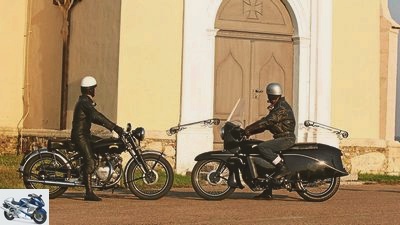
Paulovits
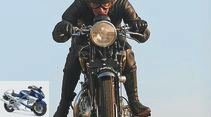
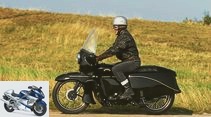

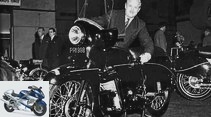
19th photos
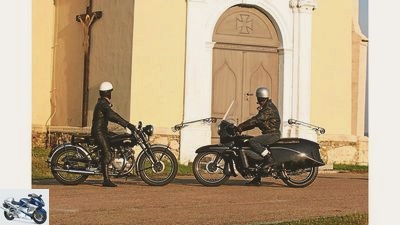
Paulovits
1/19
There are motorbikes that chase you for a lifetime. This definitely includes Vincent’s motorcycles.
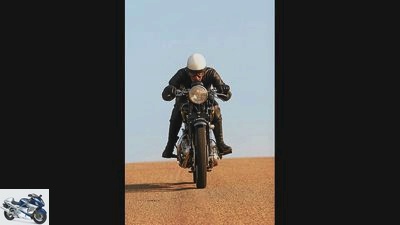
Paulovits
2/19
Driving a Vincent once in a lifetime is a dream for many people.
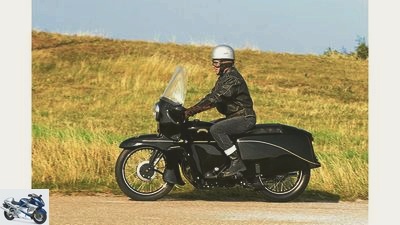
Paulovits
3/19
The Vincent White Shadow: For thousands of people from the 50s, very compact seating position, motor with tremendous pressure in all situations.

Paulovits
4/19
Vincent launched some large V2 models – here the C series.
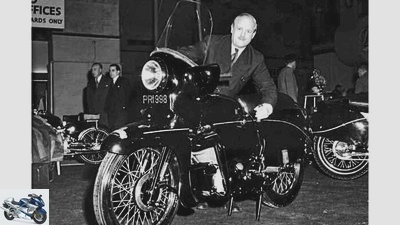
Paulovits
5/19
Phil Vincent with the Black Prince, who ultimately failed the audience.
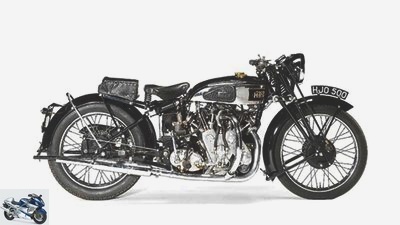
Paulovits
6/19
1936: Series A Rapide. First two-cylinder from Vincent-HRD. Cylinder angle 47.5 degrees, power 45 hp. Vincent played in the top motorcycle league.
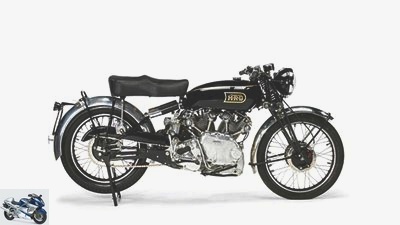
Paulovits
7/19
1946: Series B Rapide. 50-degree V2 block engine as a supporting unit, thus clearer lines. Conventional trapeze fork at the front. From 1948 Black Shadow sports model with 55 hp.
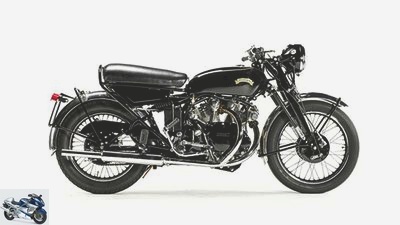
Paulovits
8/19
1955: Series D Black Shadow. Because the fully disguised Black Prince did not reach the potential customers, many copies were stripped of the disguise at the factory.
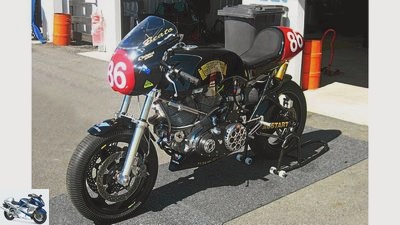
Paulovits
9/19
The Australian Irwing-Vincent who mixes up BOT races.
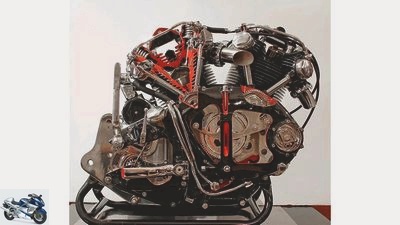
Paulovits
10/19
Black Shadow engine as a cutaway model: half-height camshafts, the rocker arms engage in the middle of the valves.
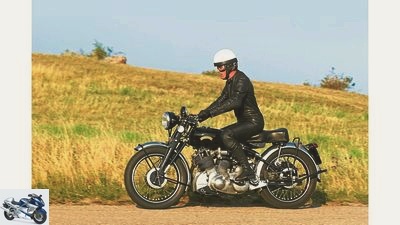
Paulovits
11/19
Tourer from the athlete: Almost the same seating position as on the Shadow, the Black Prince is nothing else than its disguised version.
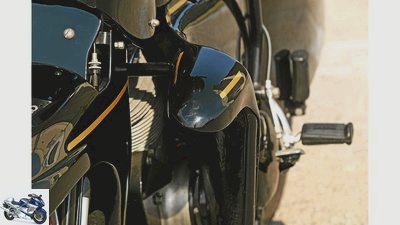
Paulovits
12/19
Well thought out: the airflow is directed away from the driver and towards the engine.
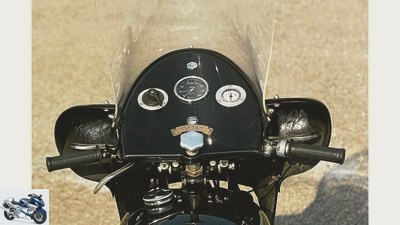
Paulovits
13/19
Something completely new in 1955: touring fairing made of GRP, dashboard behind the curved windshield.

Paulovits
14/19
The Vincent Black Prince: With the full GRP fairing, this motorcycle was way ahead of its time, but was not understood by customers.
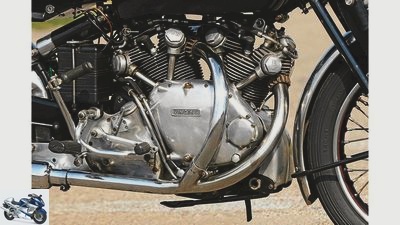
Paulovits
15/19
A picture of an engine: whether black enamelled or in bare aluminum – the tidy twin with its short bumpers embodies the finest English engine construction and exudes power.
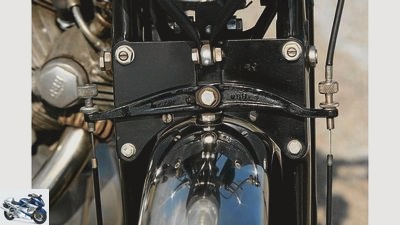
Paulovits
16/19
Thanks to a rocker, the two front drum brakes always have the same hand force when they are operated.
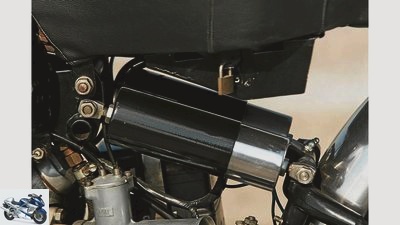
Paulovits
17/19
Cantilever suspension with two struts, with a hydraulic damper between them.
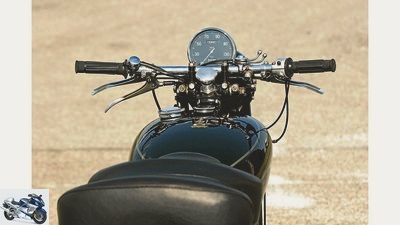
Paulovits
18/19
Lots of handles and levers, and in front of the straight handlebars the huge speedometer up to 150 miles per hour.
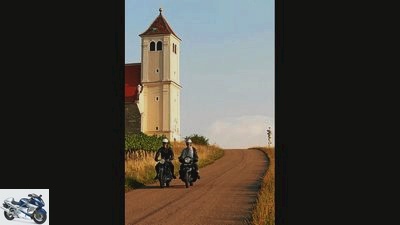
Paulovits
19/19
Motorcycling in its most beautiful form: tours with two Vincent legends.
On the move: Vincent Black Prince and White Shadow
The black magic of Vincent motorcycles
Content of
Black, strong, fast and sinfully expensive – Vincent motorcycles had and still have a magical aura. In the 1950s they were the fastest motorcycles on the market. Today they are priceless dream machines. We were lucky and were able to drive two particularly rare examples.
There are motorbikes that chase you for a lifetime. I was just 16 when I got the VIncent saw Black Shadow in a magazine for the first time. These photos burned into my memory, I still remember them today, over 35 years later: A man in black racing leather, with a white scarf and a Cromwell helmet, flees on his motorcycle from a thunderstorm to an old castle. But not on any motorcycle. But on a glossy black V2 that radiated so much power that it was sure to bring its driver safely to his destination. On the next page, a full-page picture of a huge speedometer caught my eye. It went up to 250 km / h – on a motorcycle from the late 1940s! In the middle of the booklet there was a fold-out, three-page poster of this technical marvel. In contrast, all Japanese and Italian motorcycles of that time faded. From the text I then learned that the Black Shadow was once the fastest production motorcycle, and that the Black Lightning racing version even carried many of its owners into the afterlife. The Vincent poster hung on the door to the hobby room in my parents’ house for decades.
Buy complete article

On the move: Vincent Black Prince and White Shadow
The black magic of Vincent motorcycles
The long-awaited moment
Paulovits
Driving a Vincent once in a lifetime is a dream for many people.
However, one thing has been denied to me in all these years: drive a Vincent like this one time. And now there are two, each a rarity. The fully disguised Black Prince from 1955, the last year of production of the English luxury brand, looks like it has just left the halls of Stevenage, the odometer reading is just 600 miles. An even rarer Vincent is parked next to it, not even recognizable at first glance: It looks like the weaker Rapide, but its engine contains all the ingredients that elicit the additional ten horsepower from the V2 of the Black Shadow. But the engine case does not have a black enamel layer – this Vincent is actually one of the 15 White Shadows built between 1949 and 1952, which was mainly sold in England as an understatement bike. For people who didn’t want to reveal what they actually drive right away.
Flood the open Amal-TT carburettors, close the air slide, take back the pre-ignition, pull the decompressor with the large second lever on the left end of the handlebar, set the piston of the rear cylinder just above top dead center and then step on the artfully curved kickstarter with a lot of momentum nothing happens. Only on the fifth attempt does the staccato of the huge two-cylinder finally sound, whose muffled rumble from the peashooter muffler mixes with the slurping from the open intake funnels and the grinding of the gears to a unique sound. A magical moment that sends a cold shiver down my spine, like back then when looking at the photos. I have to curb my impatience while the V2 of the White Shadow warms up and gives off the smell of Castrol oil. Then finally the V2 responds greedily to my gas commands – let’s go!
And quite high up, the comfortable double seat bench is at a dizzying height compared to the saddles on the machines from the post-war period. Together with the relatively narrow handlebars and the half-height footrests, this results in a sporty, but not uncomfortable sitting position. The clutch is easier to pull than expected, but the shift lever offers a certain resistance. Release the clutch – and the engine stops again. Oops, it suddenly works! So start again and the imposing bike starts moving with more feeling.
A world of its own
Paulovits
Black Shadow engine as a cutaway model: half-height camshafts, the rocker arms engage in the middle of the valves.
The first corner is a special kind of experience. At first the Vincent does not want to give in, requires a lot of strength to suddenly fold much further than planned. At a higher speed, the processes normalize and the White Shadow can be directed much more precisely. With good feedback from the front wheel, although it still takes a lot of power to turn.
The front and rear suspension is quite tight. Anyone who knows the chassis of other motorcycles from that time, however, will notice that the Vincent drives much more precisely. The trapezoidal fork with the long hydraulic dampers on both sides guides the front wheel very precisely, similar to current bikes. And thus worlds more accurate than the early telescopic forks, short swing arms or the simple trapeze forks of yore. The rear cantilever suspension also ironed out unevenness much better than the straight-way suspension of the time, not to mention the rigid frame. Bumps in curves, however, cause unrest because during compression the geometry of the front suspension changes so much that you have a little trouble keeping a clean line.
The brakes also warn you to be careful. Back then there was hardly anything better, but from today’s perspective, the small double drum brakes at the front and rear can of course no longer stand up to modern stoppers. So be careful if a car with ABS and brake assist hits you in front of you. A forward-looking driving style is therefore the top priority with a Vincent.
A rush for the senses
Paulovits
The Vincent White Shadow: For a thousand people from the 50s very compact seating position, motor with tremendous pressure in all situations.
Not that easy, because the 60-year-old Vincent‘s powerful engine is still inspiring today. Especially with its smooth throttle response and power delivery, which many current high-performance V2 can only dream of. The White Shadow has a lot of pressure, especially in the middle, so you never feel underpowered, even with today’s traffic. Wonderful and wonderfully relaxed, this ride on the torque wave! This engine in a modern chassis – it certainly doesn’t have to shy away from comparison with many today’s motorcycles.
Especially not with its wonderful sound, which nowadays is neither available for money nor good words. When accelerating, the roar of the exhaust vies with the roar from the intake funnel, the intensity being determined by the right hand. And when the sliders are closed, the dull rumble inevitably raises the hairs on the neck. No question about it, this motorcycle is alive, and it lets us all share in its unbridled joie de vivre.
Likewise the Black Prince. No wonder, it is nothing more than a Black Shadow with full fairing. In terms of appearance, it is a rather idiosyncratic exotic, with idiosyncratic details. For example, the main stand is operated with a long hand lever. The machine is jacked up in a vertical position; to jack it up, it must be brought forward into a horizontal position.
The start-up procedure is of course the same as with the White Shadow, but the sound experience is different. The intake noise and the grinding gears are dampened by the cladding, which makes the exhaust sound more distinctive. Compared to the Feridax Dunlopillo of the Shadow, the bench of the clad is softer, but doesn’t offer as much support for the very best.
The Black Prince inherited the slim handlebar from the undisguised one. Compared to modern tourers, this gives the Vincent an unusual feeling behind the high windshield. It’s just strange that the Black Prince’s handling feels less stubborn, although the chassis is identical to that of the Shadow. At higher speeds, the curved windshield provides good wind protection. In general, it is astonishing how well the Vincent men formed the casing. The wind noise is moderate, as is the suction effect, with which generations of later cladding builders had to struggle.
Great story
Paulovits
The Vincent Black Prince: With the full GRP fairing, this motorcycle was way ahead of its time, but was not understood by customers.
On the narrow country roads, the Vincent not only beguiles the senses, but also gets the imagination going. I imagine the British motorcycle aristocracy driving through the hills of Kent towards Brighton when the weather was nice. And feel more with every kilometer that these motorcycles were created by people who had a very special penchant for mechanical engineering and also for perfection.
The story of Vincent was also a very illustrious one. It goes back to the racing driver Howard Raymond Davies. At some point the senior TT winner from 1921 was fed up with the ailments of his machines and the constant technical failures. That is why he founded his own motorcycle factory in 1924. With the machine named HRD, he promptly won the Senior TT in 1925. His pursuit of perfection appealed to customers, but not to banks. Davies paid on every motorcycle and soon went broke.
The naming rights to HRD and the tools were acquired by a young Cambridge graduate Chris Vincent, whose family had made wealth in Argentina by raising cattle. He set up a factory in Stevenage and named his motorcycles “The Vincent HRD”. In 1931 he strengthened himself with the Australian engineer Phil Irwing and from 1934 was able to replace the built-in motors with his own engines. After the Second World War, Vincent really took off, from 1950 without the abbreviation HRD, because he feared the danger of confusion with Harley-Davidson in the important American market. Only “The Vincent” could be read on the tanks. Although more and more customers preferred cars to expensive motorcycles in the mid-1950s, Vincent did not want to compromise the quality of his bikes. This made the production unprofitable, which had to be stopped in 1955. However, Vincent promised that there will always be spare parts. A promise that the Vincent Owners Club has kept to this day. He ensures the supply of spare parts through selected suppliers. For this reason alone, Vincent now has a special position among the classics – and prices that have skyrocketed.
Much to my sorrow. Because after this ride I want Vincent even more. I used to know that it was once the fastest production motorcycle. But not what overwhelming charisma these legendary V2 machines have.
In detail: The large v2 models from Vincent
Paulovits
Vincent launched some large V2 models – here the C series.
technology
The first engine of his own, which the Australian engineer Phil Irwing designed for Vincent-HRD in 1934, was a 500cc single-cylinder that was tilted forward by 23.75 degrees. Irwing paid great attention to the valve train with two gear-driven, half-height camshafts that operated two valves via short bumpers and rocker arms. These were guided twice, above and below, the rocker arm was positioned in the middle between them. The axial load on the valve guides should be kept as low as possible. This principle was maintained until the end of the Vincent production.
According to legend, Irwing saw two drawings of the engine lying on his drawing board, which he shifted and turned until they fit together. At least that is how the 47.5-degree V2 was created in 1936. This engine still had a separate gearbox and external oil lines, but it already produced 45 hp, which raged in a frame that was open at the bottom, which already had the cantilever suspension patented by Phil Vincent with triangular rocker and two struts attached to the frame backbone. This Series A Rapide shone with further pioneering details such as the four-speed gearbox and side stand. Vincent manufactured armaments during World War II, and Irwing spent much of his spare time building it up. In this way, he combined the engine and transmission into one unit that was so powerfully dimensioned that it could serve as a load-bearing element of the chassis. The cylinder angle grew to 50 degrees, only a sheet metal profile was screwed onto the two cylinder heads, which accommodated the steering head and also served as an oil tank. The external oil lines disappeared in the engine. The whole motorcycle now looked much more compact and tidy.
A trapeze fork was still used in front. Instead of the single swinging saddles that were common up until then, the Vincent got a Feridax Dunlopillo double bench seat, which was supported by a strut on the swingarm at the back. The motorcycle, now called Series B Rapide, made its debut in 1946, the Black Shadow with a black enamelled engine followed in 1948. Its compression ratio was increased from 6.8 to 7.3, many innards were polished, and the power increased to 55 hp. With sharper camshafts and – depending on the fuel – up to 12.5 compression, the racing version Black Lightning developed 70 hp, many aluminum parts reduced the weight to around 170 kilograms.
In 1949 the Series C appeared with a girdraulic fork, a trapezoidal fork with attached hydraulic dampers. In 1955 Vincent equipped his entire program with GRP cladding. The Rapide became the Black Knight and the Black Shadow
the Black Prince. Today’s specialists show the potential in the engine. The Australian Irwing Vincent BOT racer brings it from 1600 cm³ to up to 186 hp!
Purchase check
Paulovits
Phil Vincent with the Black Prince, who ultimately failed the audience.
When choosing a Vincent V2, the history is crucial. Since it is a very expensive purchase in any case, you should consult a specialist for the inspection. According to Kurt Schupp, President of the German Vincent Owners Club, offers below 60,000 euros should be skeptical. “Everything that has been screwed together somewhere should be treated with caution. If you don’t know exactly what the engine looks like inside, it can be very expensive to rebuild,” says Schupp. “A Vincent purchase is always a matter of trust. So you should know who is selling the motorcycle. When a club member sells a motorcycle, you can assume that the offer and the price are in harmony. “
market
Vincent two-cylinders are coveted collector’s items and rarely change hands. Rapide can still be found, only one or two Black Shadow and Black Prince machines are up for sale each year, Black Lightnings or even a White Shadow are almost never offered. Flawless Black Shadow with matching chassis and engine numbers are now 150,000 euros. The spare parts supply is very good; every single Vincent part can be obtained from the Vincent Owners Club.
Specialists
Hugo Baumeler
spares@vincent-hrd.ch,
www.vincent-hrd.ch
Hartmut Weidelich
Telephone 0 74 24/8 66 54,
www.britishclassicbikes.de
Patrick Godet
Telephone 00 33/2 35 75 96 56,
www.godet-motorcycles.com
Bob Dunn
Telephone 00 44/16 17 97 55 35
Clubs and forums
Vincent Owners Club Germany
President Kurt Schupp
Telephone: 0 64 45/54 02
Vincent Owners Club
Telephone 00 44/79 77 00 10 25,
www.vincentownersclub.co.uk
Related articles
-
On the move: Vincent Black Shadow
Nakamura On the move: Vincent Black Shadow The last of its kind Content of In 2007 the last Black Shadow of the Series C went under the hammer at the…
-
Nakamura 11 photos Nakamura 1/11 And the innovations are worthwhile. The Black Shadow is easy to control on the road. Here Alan Cathcart pounds across…
-
Auction Vincent Black Shadow HRD 1000 Series D
Catawiki 8 images Catawiki 1/8 This Vincent Black Shadow HRD 1000 Series D is currently being auctioned at Catawiki. Estimate: 110,000 to 145,000 euros ….
-
Unrestored Vincent Black Lightning
Kel Edge 11 pictures Kel Edge 1/11 With this Vincent Black Lightning, still unrestored today, racing driver Jack Ehret once broke the Australian …
-
Siemer On the move: Moto Guzzi V7 Steam announcement Content of No teeth in the mouth, but La Paloma whistles: This is what it looked like when Moto…
-
Vincent Black Lightning Record Auction
Bonhams 6 pictures Bonhams 1/6 An extremely rare Vincent Black Lighning was auctioned at the Bonhams auction house. Bonhams 2/6 From this model …
-
On the move with the BMW R 69 S.
Gargolov 30th photos Gargolov 1/30 Gargolov 2/30 Gargolov 3/30 Gargolov 4/30 Gargolov 5/30 Gargolov 6/30 Gargolov 7/30 Gargolov 8/30 Gargolov 9/30…
-
On the move with Majestic 350 from 1930 and Bimota Tesi 1D-SR from 1992
41 photos r-photography.info 1/41 Picture gallery: Majestic 350 from 1930, Bimota Tesi 1D / SR from 1992. r-photography.info 2/41…
-
On the move with the Egli-Ducati 960 and Egli-Vincent 1000
Jahn 25th photos markus-jahn.com 1/25 Egli-Ducati 960. markus-jahn.com 2/25 Double fleet: The layout of the cylinders and their heads on the V2 largely…
-
On the move with the Egli MRD1
Gargolov 28 photos Gargolov. 1/28 Egli MRD1. Gargolov. 2/28 Egli MRD1. Gargolov. 3/28 Egli MRD1. Gargolov. 4/28 Egli MRD1. Gargolov. 5/28 Egli MRD1….